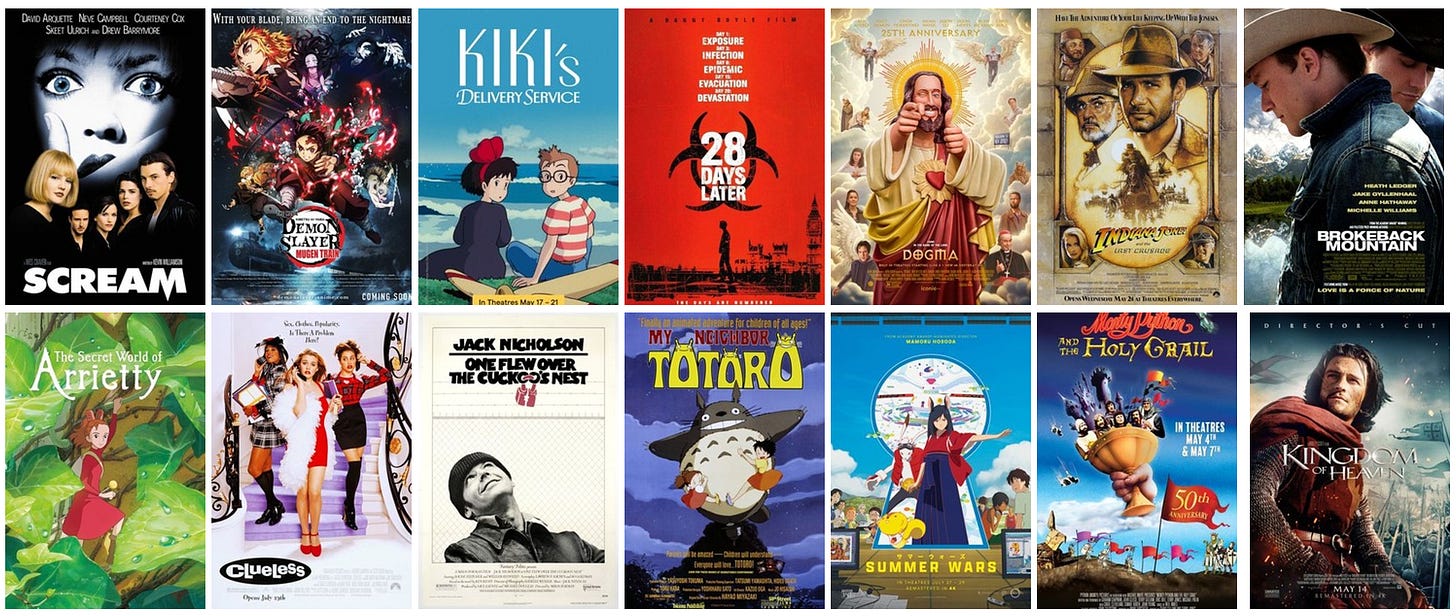What makes a movie re-release work (and what makes them fail)
2025 is packed with re-releases hitting the big screen. But not all are destined to make money. Here’s what seems to separate the successful re-releases from the failures.
Theatrical re-releases used to be a minor feature of the cinema calendar. But recently we’ve seen a flurry of headline-grabbing successes, and there are quite a few coming down the pipe.
Cinemas are packed with re-releases in 2025, offering everything from cult favourites to landmark anniversaries. Titles returning to the big screen include 28 Days Later, Demon Slayer: Mugen Train, Dogma, Brokeback Mountain, and a full Studio Ghibli slate celebrating 40 years of the iconic animation studio. Whether it's the 75th anniversary of Sunset Boulevard, the 60th of The Sound of Music, or the 50th of Jaws, this year’s calendar is stacked with chances to revisit classics in theatres.
If the past is any indication, some of these will bring in millions while others will collapse entirely.
In the same year that Coraline earned over $29 million in a limited run, Snow White struggled to attract more than 17 people per screen.
Revenge of the Sith packed cinemas two decades after its first release, while Morbius failed a second time despite widespread internet attention.
Understanding why a re-release works means looking closely at timing, audience connection, presentation quality and cultural context. Success depends on alignment. When the right factors converge, even a film from fifteen years ago can feel like a significant new event.
From looking at the data, I see four conditions for success:
A strong emotional connection. Films with a lasting fanbase or cultural presence attract audiences who feel personally invested.
A clear temporal hook. Re-releases work best when aligned with anniversaries, seasonal slots or sequel build-up.
A presentation that adds value. Upgrades like 4K, 3D or added footage give returning viewers a reason to see the film again.
A cultural connection (that has grown over time). Movies that have grown in reputation or visibility since their original release benefit from renewed interest.
Let’s look at each in detail…
1. A strong emotional foundation
The starting point is affection, meaning that movies with a devoted fan base or enduring cultural presence have a clear advantage. This is not to be confused with critical acclaim or box office history - we’re talking about lasting emotional value.
For the re-release of Coraline, Laika built its re-release campaign over five years. The studio posted regular behind-the-scenes content and built a following of more than ten million across platforms. By the time the 15th anniversary arrived, fans were ready. The film returned with 4K and 3D upgrades, new footage and a limited run through event cinema distributors. It earned more than $29 million globally and became the most successful classic title for Fathom Events to date.
Revenge of the Sith followed a different path but relied on the same principle. The perception of the Star Wars prequels has changed since their first release. What once felt polarising now feels personal to a generation who grew up with them. Disney released the film in May 2025 to mark its twentieth anniversary. It aligned with Star Wars Day and included surprise cast appearances. The run earned over $42 million and helped the film cross $900 million lifetime.
2. A clear temporal hook
The next thing that a successful re-release needs is context. The best examples are tied to a specific moment, such as an anniversary, a new sequel, or a seasonal window. This timing creates urgency and gives the audience a reason to return now rather than wait for streaming.
The 2012 3D version of Titanic grossed $350 million, with the 2023 reissue adding another $70 million. In both cases, the presentation quality helped, but the timing was essential. The campaigns positioned each release as a celebration, not just a reprint.
The 2022 re-release of Avatar was timed to prepare audiences for the sequel. IMAX and 3D formats drove most of the sales. In some markets, they accounted for more than 75% of tickets. The film earned over $30 million in its opening weekend alone.
3. A presentation that adds value
Modern audiences expect more than nostalgia. The theatrical experience must offer something that streaming cannot match. That might include visual upgrades, exclusive footage or a communal setting.
Keep reading with a 7-day free trial
Subscribe to StephenFollows.com - Using data to explain the film industry to keep reading this post and get 7 days of free access to the full post archives.





